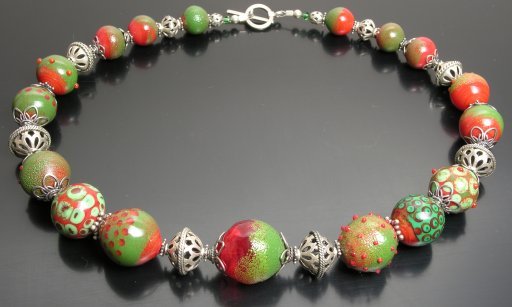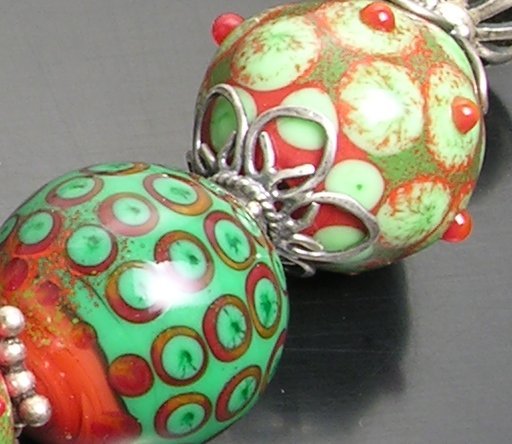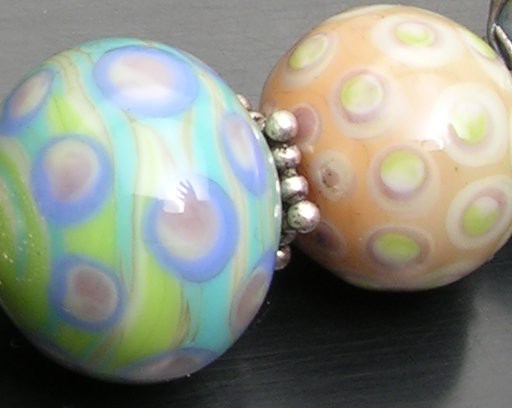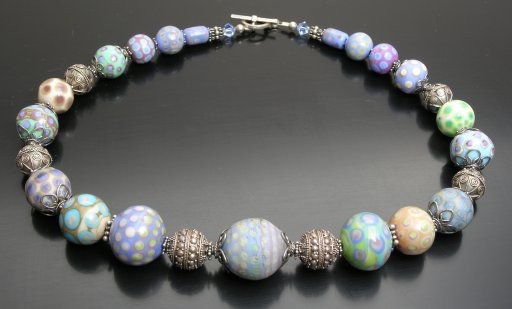I couldn't even begin to guess when I made these beads, or Page strung them into these elegant designs; and though there are some, um, issues, especially with roundness, I have a real fondness for these older beads, and am delighted to have gotten the chance to photograph them.

Gazpacho necklace. Sodalime glass, thompson enamels, ethnic silver. Tigertail. Perhaps 20” long. Page, of course, came up with the catchy title to this piece. Copyright Page Brunner; all rights reserved.
These necklaces are excellent examples of collaborative design, the red and green piece especially, as Page specified the parameters of the beads. I remember being dubious—perhaps because I thought the limited palette would be boring—but as usual, her vision prevailed.

A closeup of two beads, which I'm guessing are roughly 15–18mm hole to hole. The base glass on the left bead is pig: note its greater color variation and tendancy to orangeyness. Hmm. That dotted thompson enamel is rather interesting. Perhaps I should play with this...?
This next necklace is from my point of view a tribute to patience (and, I'm happy to report glass) that I no longer possess. Most of the beads—certainly the cream and pale brown ones—are made with the infamous PIG, or “Perfect International Glass”—an indian product I got from Arrow Springs ’cuz it was cheap—$5/lb—and to which I'm forever grateful. If you know anything about lampworkers’ sodalime glass, you might be forgiven for scratching your head at this point, because this was absolutely the most horrible glass anyone had ever used. Everything was wrong with it.
It had stones. It had seeds. It had bubbles, loads of them. It had muddy colors. Most of the ‘pastel’ colors (cool color opaques) boiled at the slightest provocation. It was unevenly pulled. It was not particularly compatible with itself. It was horribly shocky, spitting shards all over—sometimes, no matter how slowly and carefully you warmed it up.
So why am I singing its praises (while rejoicing in its absence)? —Well, cuz after fighting with stuff, everything since (no matter how much I've whined) has been so much easier by comparison. Nothing beat pig for ramping one's skills up, in a whole variety of ways.

closeup of two beads made with pig. Note the lack of reaction between the ivory and turquoise in the bead on the left, which would've shown up as a strong, sharp demarcation had the bead been made in Italian glass. You can see my hand holding the diffuser on the left bead. Ah, well.
Not all the beads in this necklace were made with pig; but all the ones with brown or dark ivory were; and quite possibly the ones that look like they're made with EDP are as well, as I don't believe the Moretti factory was producing this color at this time. (Yes, this piece almost certainly dates back to before Moretti was sold, before Vetrofond, let alone czech glass was available...)
There is positively no way I could make the bead on the right now: it probably took 4x the time an equivalent bead, made with Vetrofond dark ivory, would take; and smoothing hollow spotted beads into nice rounds just adds more pain to the process. The colors used to make these beads were softer than moretti—their coe's tested as high as 130—(as the transparents were generally harder, as low as 90) but, as I said they boiled like crazy besides being so shocky that even preheating, once I got past the 1” or so that had preheated in the kiln, the rod would start popping and I'd put it back in the kiln and get out a different rod (of the same color) to continue.
As I said, I had a lot more patience for that sort of futzing around back then, but as you see, the glass, horrid as it was, came in some very beautiful colors that still are not really available in the Italian palette—the closest would be Bullseye, or perhaps Satake. —Luscious as the limes, purples, tans and creams were (that mint is still not available in 104) the last time I tried to make beads with the glass I got so disgusted with all the spitting I pitched all the opaques I had left (the reds, featured in the gazpacho necklace, were much better behaved, besides being compatible with Effetre and thus had long since been used up). I still have some of the transparents left, —I like them for making antique beads, for which the scuzzy quality of the glass is a plus—but their day is coming...
Unless otherwise noted, text, image and objects depicted therein copyright 1996--present sylvus tarn.
Sylvus Tarn